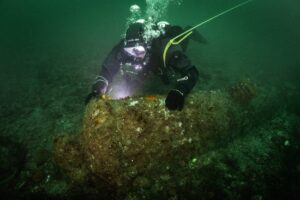The Red Sea is always sunny, but by the time I visited, as November gave way to December, the endless Egyptian summer was starting to slip away. The Red Sea is an unusual slice of the ocean, because despite being a coral sea, being situated so far from the equator means it is also resolutely seasonal. A late summer trip sees water temperatures up to 30˚C and most divers just in rash vests, while the end of the winter sees boat-loads of semi-drys and drysuits to protect from the cooling winds and the water chilling into the teens. November is a month of change: windy days can be frigid, while calm weather brings summer back. I found my 5-4-3mm Flexa was perfect, although I did make sure I packed my warmer Flexa Hood just in case we got unlucky with windy weather. My luxury item on this trip was my XR Tek Shorts, which I wore over my wetsuit for the macro dives as they are amazing for carrying photography accessories.
Like many keen divers, I have done a lot of trips to the Egyptian Red Sea. I am not sure of the exact total, but I do know that I have run 24 liveaboard photography workshops there. While the wrecks, reefs and fish don’t leave the Red Sea, timing really makes a difference to the photographic potential of this seasonal sea. The cooler waters of spring are often best for sharks, particularly thresher sharks and schooling hammerheads at the offshore reefs. High summer, when the days are at their longest, is my favourite time to visit Sinai, for this is the season when great spawning schools gather in the Ras Mohammed National Park. The Red Sea has these very large aggregations because of the marked seasonality. In other parts of the world, these same species spawn all year round in less spectacular gatherings. Late autumn is the season when my attention turns to southern Egypt looking for encounters with both longimanus and longirostris – oceanic whitetip sharks and spinner dolphins, respectively.
This was my first trip back to the Red Sea since pre-Covid times, and the plan was to focus on colourful, vibrant reef diving around Sinai. I don’t usually dive these reefs in this season, and there were plenty of seasonal treats. School of glassfish were particularly prevalent, we had swirling schools of them on 7 different sites. I particularly enjoyed the low angle of the sun at this time of the year, which gave us beautiful underwater sunbursts on two of the three dives each day. The middle dive would feel like summer, but the first and third dives felt much more like extended early morning and evening dives. The low angle of the sun also cast more of the reefs into shadow, which meant that the colourful soft corals were more often unfurled during the day. Divers typically prefer to dive a reef when it is fully illuminated by the sun, but we photographers often find it better for photos when everything is in shadow. The angled sunlight also produced more moody light on the classic wrecks we visited and was well suited to both black and white pictures and for shooting colourful features with hulking, silhouetted wreckage as a backdrop.
My next trip to these picturesque Sinai reefs is in mid-summer with high sun and long days (and big schools), but I’ll definitely be planning a return in November for the atmospheric underwater conditions brought by the low sun at the very end of the Red Sea summer.
The post The Last of the Summer in the Red Sea appeared first on Mares – Scuba Diving Blog.
Read MoreDiving, diving, fish, Mares, ocean, photography, red sea, underwaterMares – Scuba Diving Blog

